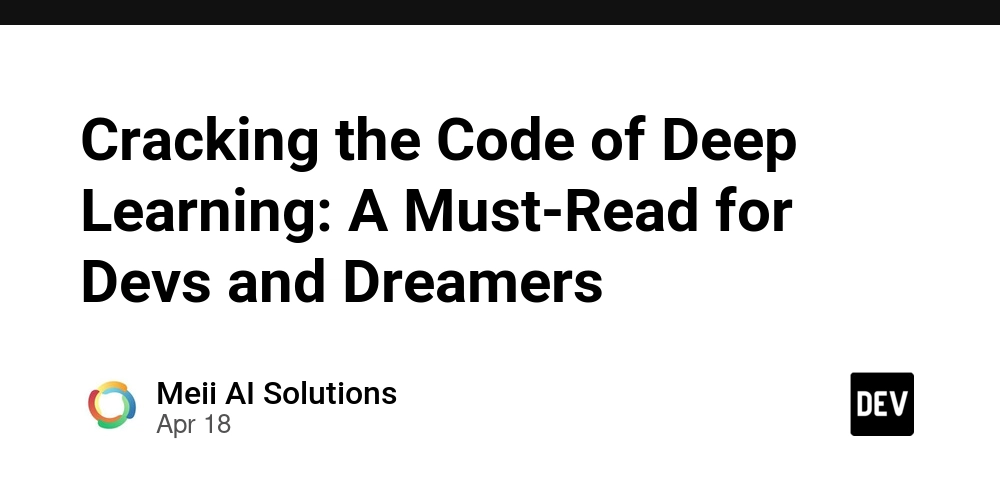Cracking the Code of Deep Learning: A Must-Read for Devs and Dreamers
Cracking the Code of Deep Learning: A Must-Read for Devs and Dreamers Deep learning has become the nucleus of modern artificial intelligence, powering everything from voice assistants and recommendation systems to medical imaging and autonomous vehicles. For developers diving into AI or dreamers envisioning the future, understanding deep learning is no longer optional—it's essential. This blog aims to demystify deep learning from the ground up, covering the key concepts, architectures, and techniques that make it tick. What is Deep Learning, Really? At its core, deep learning is a subset of machine learning that uses artificial neural networks (ANNs) with many layers—hence the term "deep." These networks are inspired by the human brain’s structure, consisting of neurons and synapses, and are capable of learning complex representations of data through hierarchical abstraction. Where traditional machine learning often relies on hand-engineered features, deep learning automatically discovers these features from raw data, making it particularly powerful for high-dimensional and unstructured inputs such as images, audio, and text. Neural Networks: The Engine Behind Deep Learning A neural network consists of layers of nodes: Input Layer: Receives raw data. Hidden Layers: Perform transformations through weighted connections and nonlinear activation functions. Output Layer: Produces the final prediction or classification. Each node, or "neuron," performs a weighted sum of its inputs and passes the result through an activation function such as ReLU, sigmoid, or tanh. The choice of activation can drastically influence training dynamics and performance. The network learns by minimizing a loss function—for example, cross-entropy for classification or mean squared error for regression—using backpropagation and optimization algorithms like Stochastic Gradient Descent (SGD) or Adam. The Power of Depth and Width The "deep" in deep learning is not just marketing. Adding more hidden layers allows the network to model increasingly complex and abstract patterns. However, depth introduces challenges such as vanishing gradients, where early layers learn very slowly due to the compounding effect of derivatives less than 1 during backpropagation. Modern architectures mitigate this using techniques like: Batch Normalization: Stabilizes and accelerates training by normalizing activations. Residual Connections (ResNets): Skip connections that allow gradients to flow more directly. Dropout: A regularization technique that randomly deactivates nodes during training to prevent overfitting. Popular Deep Learning Architectures Understanding deep learning also means understanding its major architectures, each tailored to specific data types and tasks. 1. Convolutional Neural Networks (CNNs) Ideal for image data, CNNs use convolutional layers to detect spatial hierarchies and patterns—edges, textures, and objects. Key components include: Filters/Kernels: Small matrices that slide across the input to extract features. Pooling Layers: Downsample feature maps to reduce dimensionality and computation. Fully Connected Layers: Integrate spatial features for classification or regression. Applications: Image classification (e.g., ResNet), object detection (e.g., YOLO), image segmentation (e.g., U-Net). 2. Recurrent Neural Networks (RNNs) Designed for sequence data, RNNs maintain an internal memory to capture temporal dependencies. However, vanilla RNNs struggle with long-term dependencies, which led to the development of: Long Short-Term Memory (LSTM) networks Gated Recurrent Units (GRUs) Applications: Time series prediction, speech recognition, machine translation. 3. Transformer Models Transformers have revolutionized deep learning, especially in natural language processing. Unlike RNNs, they process input in parallel and use self-attention mechanisms to weigh the relevance of each word in a sentence. Key innovations: Positional Encoding: Adds order to input tokens. Multi-Head Attention: Captures different contextual relationships. Feedforward Networks: Applied independently to each position. Applications: Language modeling (e.g., GPT), translation (e.g., BERT), image generation (e.g., Vision Transformers or ViTs). Training Deep Networks: Tools and Techniques Training deep neural networks is computationally expensive and data-hungry. Key elements of successful training include: Weight Initialization: Poor initialization can stall learning or lead to exploding gradients. Learning Rate Schedules: Strategies like cosine annealing or warm restarts can boost convergence. Data Augmentation: Enhances generalization by synthetically increasing dataset diversity. Transfer Learning: Fine-tuning a pre-trained model on a new dataset is often faster and more effective than training from scratch. Frameworks like

Cracking the Code of Deep Learning: A Must-Read for Devs and Dreamers
Deep learning has become the nucleus of modern artificial intelligence, powering everything from voice assistants and recommendation systems to medical imaging and autonomous vehicles. For developers diving into AI or dreamers envisioning the future, understanding deep learning is no longer optional—it's essential. This blog aims to demystify deep learning from the ground up, covering the key concepts, architectures, and techniques that make it tick.
What is Deep Learning, Really?
At its core, deep learning is a subset of machine learning that uses artificial neural networks (ANNs) with many layers—hence the term "deep." These networks are inspired by the human brain’s structure, consisting of neurons and synapses, and are capable of learning complex representations of data through hierarchical abstraction. Where traditional machine learning often relies on hand-engineered features, deep learning automatically discovers these features from raw data, making it particularly powerful for high-dimensional and unstructured inputs such as images, audio, and text.
Neural Networks: The Engine Behind Deep Learning
A neural network consists of layers of nodes:
- Input Layer: Receives raw data.
- Hidden Layers: Perform transformations through weighted connections and nonlinear activation functions.
- Output Layer: Produces the final prediction or classification.
Each node, or "neuron," performs a weighted sum of its inputs and passes the result through an activation function such as ReLU, sigmoid, or tanh. The choice of activation can drastically influence training dynamics and performance. The network learns by minimizing a loss function—for example, cross-entropy for classification or mean squared error for regression—using backpropagation and optimization algorithms like Stochastic Gradient Descent (SGD) or Adam.
The Power of Depth and Width
The "deep" in deep learning is not just marketing. Adding more hidden layers allows the network to model increasingly complex and abstract patterns. However, depth introduces challenges such as vanishing gradients, where early layers learn very slowly due to the compounding effect of derivatives less than 1 during backpropagation.
Modern architectures mitigate this using techniques like:
- Batch Normalization: Stabilizes and accelerates training by normalizing activations.
- Residual Connections (ResNets): Skip connections that allow gradients to flow more directly.
- Dropout: A regularization technique that randomly deactivates nodes during training to prevent overfitting.
Popular Deep Learning Architectures
Understanding deep learning also means understanding its major architectures, each tailored to specific data types and tasks.
1. Convolutional Neural Networks (CNNs)
Ideal for image data, CNNs use convolutional layers to detect spatial hierarchies and patterns—edges, textures, and objects.
Key components include:
- Filters/Kernels: Small matrices that slide across the input to extract features.
- Pooling Layers: Downsample feature maps to reduce dimensionality and computation.
- Fully Connected Layers: Integrate spatial features for classification or regression.
Applications: Image classification (e.g., ResNet), object detection (e.g., YOLO), image segmentation (e.g., U-Net).
2. Recurrent Neural Networks (RNNs)
Designed for sequence data, RNNs maintain an internal memory to capture temporal dependencies. However, vanilla RNNs struggle with long-term dependencies, which led to the development of:
- Long Short-Term Memory (LSTM) networks
- Gated Recurrent Units (GRUs)
Applications: Time series prediction, speech recognition, machine translation.
3. Transformer Models
Transformers have revolutionized deep learning, especially in natural language processing. Unlike RNNs, they process input in parallel and use self-attention mechanisms to weigh the relevance of each word in a sentence.
Key innovations:
- Positional Encoding: Adds order to input tokens.
- Multi-Head Attention: Captures different contextual relationships.
- Feedforward Networks: Applied independently to each position.
Applications: Language modeling (e.g., GPT), translation (e.g., BERT), image generation (e.g., Vision Transformers or ViTs).
Training Deep Networks: Tools and Techniques
Training deep neural networks is computationally expensive and data-hungry. Key elements of successful training include:
- Weight Initialization: Poor initialization can stall learning or lead to exploding gradients.
- Learning Rate Schedules: Strategies like cosine annealing or warm restarts can boost convergence.
- Data Augmentation: Enhances generalization by synthetically increasing dataset diversity.
- Transfer Learning: Fine-tuning a pre-trained model on a new dataset is often faster and more effective than training from scratch.
Frameworks like TensorFlow, PyTorch, and JAX provide powerful APIs and hardware acceleration to streamline development and experimentation.
The Future: Towards Generalization and Efficiency
While deep learning continues to set benchmarks, the field is evolving to address key challenges:
- Explainability: Methods like SHAP and LIME are making neural decisions more interpretable.
- Efficiency: Techniques like pruning, quantization, and knowledge distillation are making models lighter and faster.
- Unsupervised and Self-Supervised Learning: Reducing dependency on labeled data through methods like contrastive learning and masked modeling.
- Multi-modal Learning: Combining vision, text, and audio into unified models (e.g., CLIP, Gemini, or GPT-4).
Closing Thoughts
Cracking the code of deep learning requires not just understanding the “how” but also the “why.” From theoretical underpinnings to real-world applications, deep learning is a rapidly evolving domain where foundational concepts remain crucial, but staying updated is equally vital. Whether you’re a developer implementing your first neural net or a dreamer envisioning AGI, the journey into deep learning is as much about curiosity as it is about computation.




























![[Webinar] AI Is Already Inside Your SaaS Stack — Learn How to Prevent the Next Silent Breach](https://blogger.googleusercontent.com/img/b/R29vZ2xl/AVvXsEiOWn65wd33dg2uO99NrtKbpYLfcepwOLidQDMls0HXKlA91k6HURluRA4WXgJRAZldEe1VReMQZyyYt1PgnoAn5JPpILsWlXIzmrBSs_TBoyPwO7hZrWouBg2-O3mdeoeSGY-l9_bsZB7vbpKjTSvG93zNytjxgTaMPqo9iq9Z5pGa05CJOs9uXpwHFT4/s1600/ai-cyber.jpg?#)













































































































































![[The AI Show Episode 144]: ChatGPT’s New Memory, Shopify CEO’s Leaked “AI First” Memo, Google Cloud Next Releases, o3 and o4-mini Coming Soon & Llama 4’s Rocky Launch](https://www.marketingaiinstitute.com/hubfs/ep%20144%20cover.png)





































































































































































































![Rogue Company Elite tier list of best characters [April 2025]](https://media.pocketgamer.com/artwork/na-33136-1657102075/rogue-company-ios-android-tier-cover.jpg?#)







































































_Andreas_Prott_Alamy.jpg?width=1280&auto=webp&quality=80&disable=upscale#)































































































![What’s new in Android’s April 2025 Google System Updates [U: 4/18]](https://i0.wp.com/9to5google.com/wp-content/uploads/sites/4/2025/01/google-play-services-3.jpg?resize=1200%2C628&quality=82&strip=all&ssl=1)








![Apple Watch Series 10 Back On Sale for $299! [Lowest Price Ever]](https://www.iclarified.com/images/news/96657/96657/96657-640.jpg)
![EU Postpones Apple App Store Fines Amid Tariff Negotiations [Report]](https://www.iclarified.com/images/news/97068/97068/97068-640.jpg)
![Apple Slips to Fifth in China's Smartphone Market with 9% Decline [Report]](https://www.iclarified.com/images/news/97065/97065/97065-640.jpg)
































































































































